
Big Foot ancestral Goa
- Introduction about Goa
- Introduction about Ancestral Goa
- Ancestral Goa - Culture and Tradition
- References
- Contact Details
- Credits
Many believe that the name goa was given by the Portuguese who came to india in 1400’s but even before that, the state of goa was known as gomanta, gova or gowapuri which were also the name of the ports at the zuari river since the beginning. A strip of land which is 110 kilometer in length and 60 km in width which is known as modern day goa. It lies between Western Ghats (sahayadri range) and the Arabian Sea on the west coast of India. Gova was the port in the state of gomanta and after Portuguese conquered gomanta they called it goa coz they found gomanta a very foreign. Prior to the Portuguese arrival, goa’s tradition was very much alike the rest of southern and costal India, the largest hindu community represented in goa was goud saraswat brahims who worshiped lord parshuram. Legend has that Lord Parshuram (Shri Vishnu's sixth incarnation) shot an arrow in the Arrabian Sea from the peak of the Sahyadri. This arrow hit Baannaavali (Benaulim) and made the sea recede, thus reclaiming the land of Goa.
One of the first rulers in goa were the The Maurya dynasty, they are also known as one of the pioneer to start the trading business with the Europe, greek and western country. Bhoja dynasty after maurya dynasty utilized goa as an opportunity in a well-planned manner, the interstate relation of bhoja dynasty was vast and peaceful. People of bhoja kingdom had an opportunity of trading the goods freely with the territory, many traders from different parts of india like Sumatra, kerala, Bengal and saurashtra. Production of large variety of goods triggered the trading between india and other parts of the world. Some of the well-known trading items of goa ports are calico, fine muslins, rice, areca nuts and spices. Not only that goa exported items but also imported fine quality of horses which were imported from ormuz and sold to rice and wealthy king and chieftains of Deccan. Many traders who came to goa descried it as inhabited by moors, respectable men, rich merchant and they also described goa as Rome of the orient.
The 170 sailors who sailed onto the coast of goa on their caravel ship, were the first ever Portuguese to enter Indian land. This expedition was carried out by vasco da gama, arrival of foreigner to India opened a gateway of opportunity to commence trading. As goa was filled with rice resource, which attracted many traders all across the world.as the business grew bigger, Portuguese empire took over the land of goa and claimed it to be their headquarters of India. They started to expand their kingdom throughout goa. This expansion triggered the dominance of Portugal ways and lifestyle, they created beautiful mansions, landscape and church. Their customs were influenced on the people and they were made to work under Portugal Empire. Slowly the lifestyle of Portugal took over majority of the population. Even today one can see what Portugal Empire left behind in goa.
Maendra Jocelino Araujo Alvares is the person behind the center for preservation of Art, Culture and Environment known as ancestral goa. Mr. Maendra was awarded limca book of records in 1994 for the sculpting the largest sculpture of sant mirabai, india’s singing saint on laterite rocks. This motivated him to continue the amazing journey ahead. The steps which Mr. Maendra was thinking of taking was something which only a man of utter determination and self-motivation could do. His idea was to convert a barren hill which is covered with hardy shrubbery and thorn into what is today, a master piece of artistic mind and nimble hands. Mr. Maendra has spent extensive amount of time and energy with his worker under sun and the moon, in the rain and driven wind, because only he knew what he wanted and what shape the finished project was going to take. Each year the project has amazing remarkable and noteworthy changes. He recreated the tradition and culture of goa which no longer existed, in a treasure- house of artifacts and precious items. He has also provided a vast opportunity to the locals, who usually travelled to urban area of goa for low income jobs.
Hard work of Mr. Maendra made a small town of Loutolim of goa which was inaccessible and providentially backward to hold its position in the world map of tourist. He has managed to place his village in the hall of fame and garner international acclaim for his land. Ansestral goa has become educational premise for Nature Club programs of various schools and colleges and a vital part of the syllabus of the “Environmental Study” groups as mandated by the State Board of Education, many foreigner visit this place for their annual study tours and Indian architectural study. Students from the Fashion design institute generally visit the premises to study the culturally correct garbs and the confluence thereof the east and west. Many also visit the place to study the huge variety of plants and their cures. The project of ancestral goa wouldn’t have been possible without the contribution and support of Mrs Maureen Ann Alvares, a language & literature teacher by profession. The Govt. of Goa has acknowledged the project as the "Most Innovative and Unique Project in India's Tourism Industry". It has also been recommended it as a "Very Educative Centre" for students by the state department of Education.
-
Important parts of Ancestral Goa
The welcome gateway
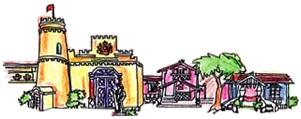
Image source: - Ancestral Goa
The fort and the facade, an armored Warrior and the entrance of the foyer to your first step into the past of Goa’s rich and eco-friendly treasury and you know you are there. You are about to begin a memorable journey, one that will carry in your soul for all time.
Castles are associated with moats and palaces with armored turrets, but your glimpse into the glory of a richly textured past is about to begin at the entrance to a sedately frozen warrior whose facial expression is not only friendly but positively benign.
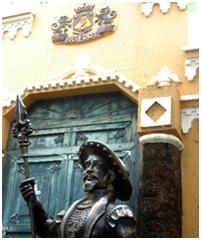
Image source: - Ancestral Goa
A gently rounded turret leads off the swan bedecked little gateway. As you near the much photographed warrior you see a low beamed structure lushly ornamented with floral designs and elephants bearing festooned pillars upon their backs.1
Sant Mirabai’s Sculpture

Image source: - Ancestral Goa
The stunning of the singing sant mirabai is 14 meters by 5 meters was created in Greco-roman style from one of the expansive stone called laterite by Mr. maendra in just 30 days.
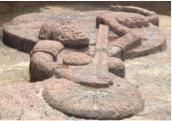
Image source: - Ancestral Goa
The Big Foot Dance Floor
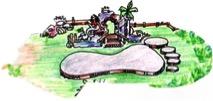
Image source: - Ancestral Goa
The giant foot designer dance floor at ancestral goa is the biggest in the Goa. It is the best venue for functions and entertainment like anniversaries, seminars, wedding etc. A sparkling illuminated fountain with water cascading over the shells and rocks enhances the beauty of the dance floor. The Big Foot dance floor, measures 40 mts. by 18 mts. and a comfortable number of 2,500 people can be accommodated in the 9,000 sq. meter area.
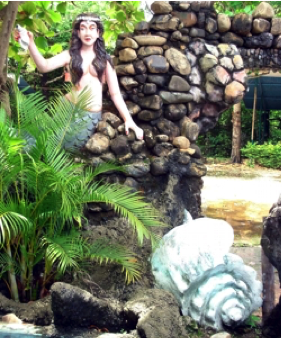
Image source: - Ancestral Goa
Legend of the Big Foot

Image source: - Ancestral Goa
The legend of the big foot starts from a person named mahadar who was a landowner, helping poor in need, with sense of duty and unending goodness. His greedy neighbor took advantage of his goodness and took all his possessions. He also lost his wife. He ask god for a small place to stand and pray. He was given a hot rock on which he stood on one leg and prayed. . Seeing his devotion the Gods took Him to heaven leaving his foot print behind with a boom“Anyone praying with a pure heart, will be blessed with luck”.
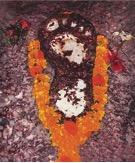
Image source: - Ancestral Goa
Rural trade trends

Image source: - Ancestral Goa
Rural trade showcase the different verity of jobs and crafts carried out by the people of goa during the Portugal era. These trades helped local to earn their daily bread and butter for living .some of the popular are the following:-

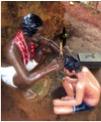
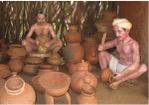
Bangle Seller Barber Potter
Image source: - Ancestral Goa
Casa de Dona Maria
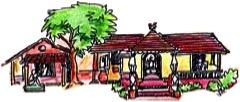
Image source: - Ancestral Goa
The typical Goan landlord's house has the influence of old Portuguese architecture. The tiled roofed homes having a welcoming look, were built on traditional norms around the 'angonn' courtyard.
Graceful curving stairways lead to a wide verandah "balcao" and are flanked by long benches. A wide doorway and narrow corridor generally led to two wings which are visible from the front of the house. The corridor bore a hat stand, wall plates and even exotic porcelain jars.
The altar housed in one room - entirely where the family priest offered mass, a dining room and even a smaller dining area for the family are more aspects of the palatial sprawling mansions. Along with the bedrooms, a huge kitchen and bathing toilet facilities, the main was complete.
Kitchens had huge areas demarcated for the fire place and firewood. A storeroom which usually led off the kitchen sported cupboards and shelves full of stores in grain, preserves and other edibles.
Food was normally cooked in terra-cotta cooking pots (budkule and kudnim) each with its characteristic shape. Goan pork sausages "Chouriços" were dried by hanging them over the fire place in the kitchen.
One window usually over looked a well from where water would be drawn for the kitchen and drinking water was stored in water cooler's called "Gurguleta".1
Reference:-
http://www.ancestralgoa.com
Ancestral Goa is a miniature of Goan village to preserve its culture and tradition built in 1995.
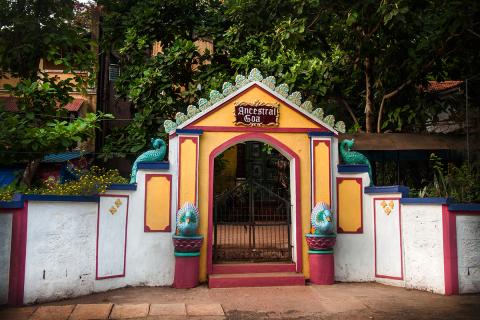
A Welcome Entryway - A gently rounded turret leads off the swan and peacock bedecked little gateway.[1]
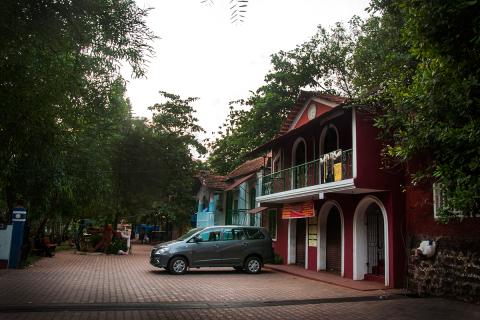
Opposite to Art gallery there is a Passage and Parking place for visitors.
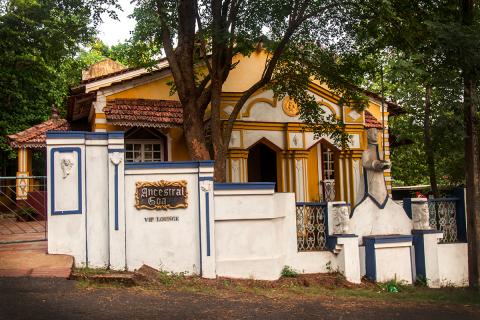
An entryway for VIP to lounge place.
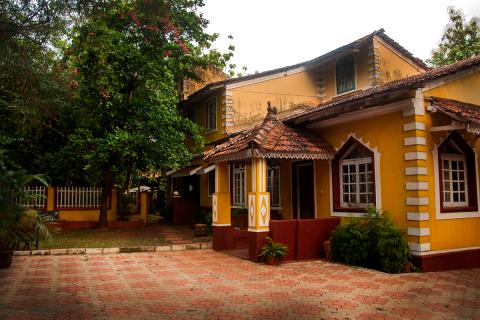
VIP lounge house in Big Foot museum.
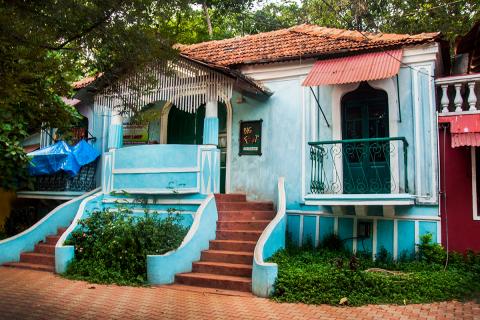
Art Gallery - Housing around twenty canvases on display at a time, this place has hosted many shows, for professional and amateur artists. The “Art Gallery” has also played forum for a number of “Artists’ Conventions”. These shows are hosted by the “Big Foot Trust” a charitable organization. [1]
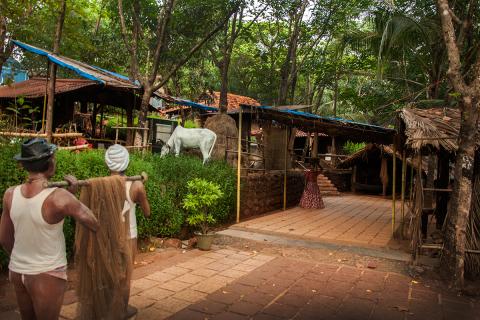
Coastal Treasure - Bounded by the coast, Goa’s pristine sands and palm lined shores from Tiracol in the north to the southernmost tip of Canacona, are some of the world’s most beaches like Calangute, Colva, Benaulim, Palolem among the few.[1]
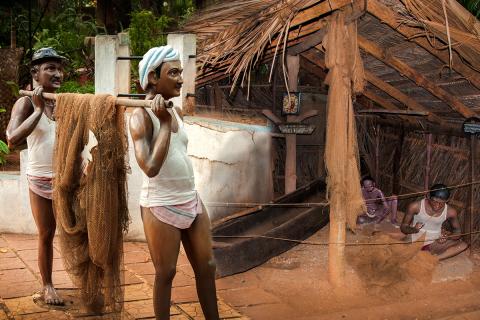
Vitorin - the fisherman - The main occupation of the people along the coastal villages was fishing. Except during the monsoons, the fishermen used to venture out to the sea in wooden boats. Nestled among the coconut tree plantations, along the coastline, the fishermen used to build a temporary shack made of coconut trunk rafters and leaves.[1]
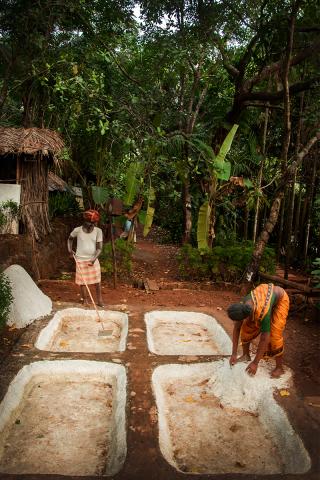
The Salt Pan - This is not to be taken with a pinch of salt but a preferable handful! River water collected in built up areas is left to evaporate and leave behind piles of muddied salt which is then reformed to a point of domestic use. In Goa, salt is used for coconut and other fruit bearing trees.[1]
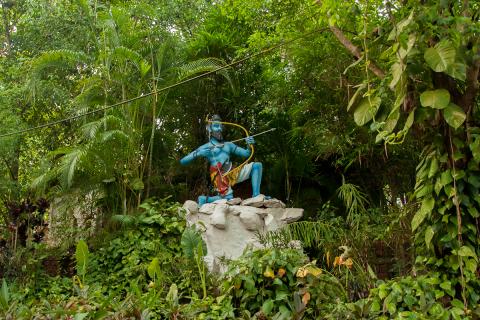
Parshuram - The Legendary Creator of the land of Goa - The Legendary Lord Parshuram the avatar of Lord Vishnu, is believed to have created the land of Goa by shooting an arrow from Sahyadri mountains into the Arabian sea.[1]
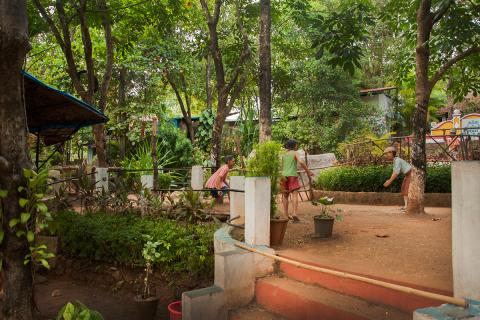
Children’s playing Traditional game – There are so many Traditional games are use to play in villages. Here Children’s are playing one of the Traditional game using Marbles. Marbles is commonly played in Rajasthan and Goa. In Goa it is known as Godden. This game is played with marbles made of glass. In this game, two or more than two players can play.[2]
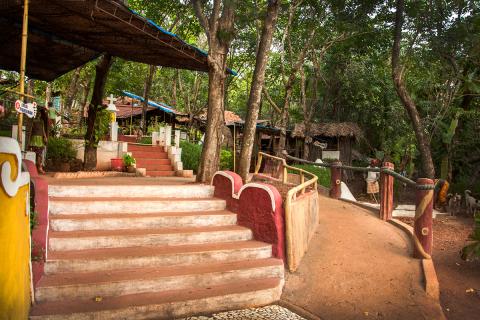
View through the Coastal Treasure model place.
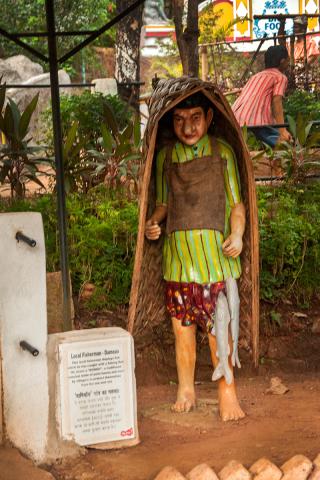
Local Fisherman wearing a woven coconut and palm-leaf Rain Coat.
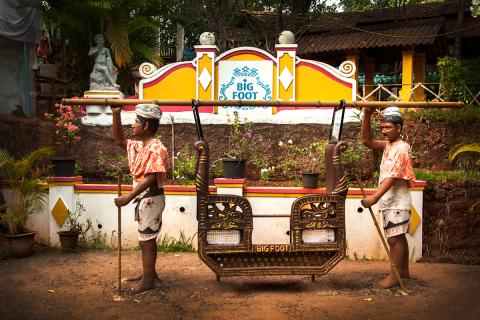
The Machila - Affordable only by the affluent and the ladies who took seated strolls for leisure! This mode is demonstrated at “Ancestral Goa”.[1]
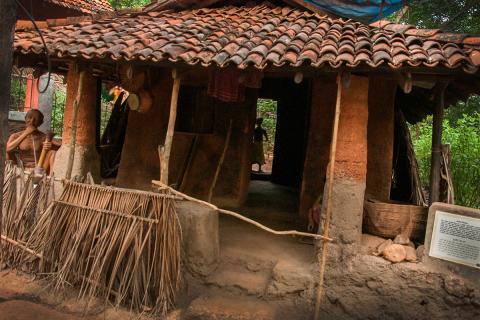
JOAO - the Goan farmer - These farmers lived in houses built of mud, laterite stone and other locally available material. The main part of the house is roofed with small clay tiles 'sulche nodde'. A cow dung paved courtyard flanked by a haystack, ploughing instruments, a woven palm-leaf 'rain coat", all lead to a narrow patio, fronting a single-room mud dwelling.[1]
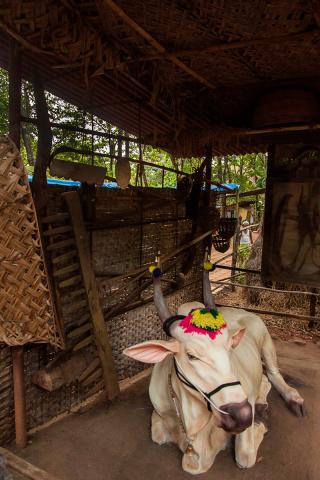
Cowshed & Haystack - A long the front yard, lies the cowshed & haystack with traditional farming tools displayed, the haystack was a form of food provision for the cattle. The implements used by the farmer were eco – friendly and designed to give maximum benefits with minimum efforts.[1]
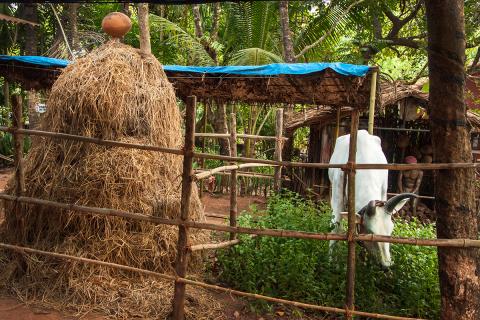
After harvesting the rice formers will collect dry rice grass and preserved in one area for cows to feed, especially in rainy season.
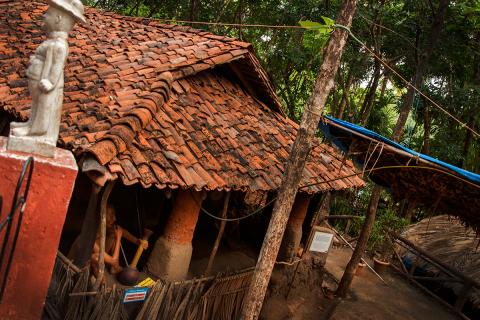
The beauties of villages are described by the way villagers happily live in the small huts or a home, made by clay or mud.[3] Sometimes clay molded Kelu are also used. Boundaries for houses and land holdings, called baras, are made of the dry branches of a nettle-like shrub, the long, sharp thorns a deterrent for straying cattle. The huts so made are technically hygienic and give the feeling of air conditioning. In summers they remain cool and in winters it remain warm.[4]
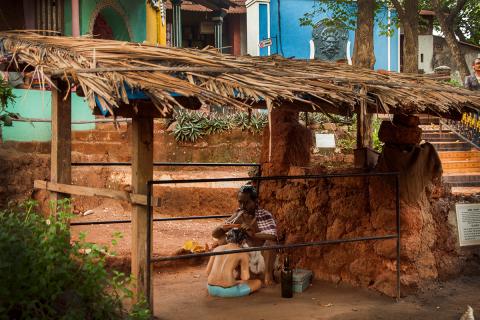
KASHANITA - The Barber - The busiest trader, the barber usually sat under a tree or a makeshift shelter. Homemade oils for a relaxing massage, a sharp and shiny blade, a wooden or tortoise shell comb, a scissor and a small mirror which was usually held by the customer whilst the barber snipped and shaved away. He also went over to the houses to perform the task and this usually was at the more affluent homes.[1]
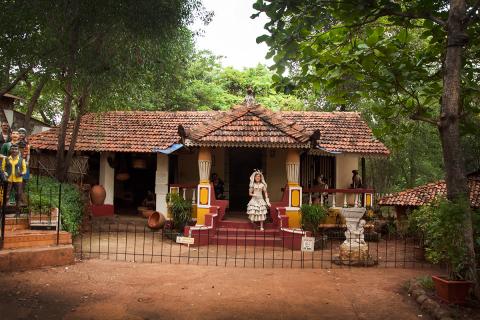
Casa de Dona Maria - The typical Goan landlord's house has the influence of Old Portuguese architecture. The tiled roofed homes having a welcoming look, were built on traditional norms around the 'angonn' courtyard. Graceful curving stairways lead to a wide verandah "balcao" and are flanked by long benches. A wide doorway and narrow corridor generally led to two wings which are visible from the front of the house. [1]
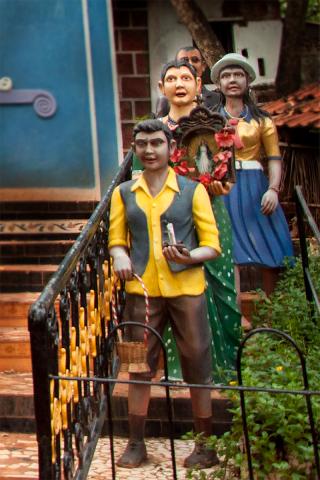
Saibinn - The practice of hosting ‘Saibin’ is still popular in Goa today, it is held in veneration of the Blessed Virgin Mary. A statue belonging to the church is displayed in a glass sided case, and carried from home to home for an overnight stay until it has been placed at all the houses of a particular ward, it then returns to the church and begins rounds at another ward.[1]
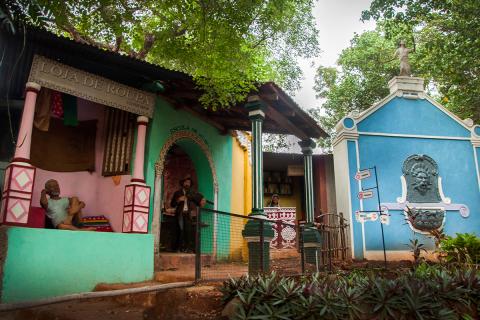
Local cloth shop & Escola de Musica (Music School) - An integral part of the Goan lifestyle, music played an important role in rural and urban Goa. In days gone by, all the children of affluent Goan families were taught music from a very tender age. Those who couldn't afford a tutor at home went to the music school where the 'Maestre' or teacher conducted his classes. The violin, guitar and piano were popular instruments which came in as a direct European influence.[1]
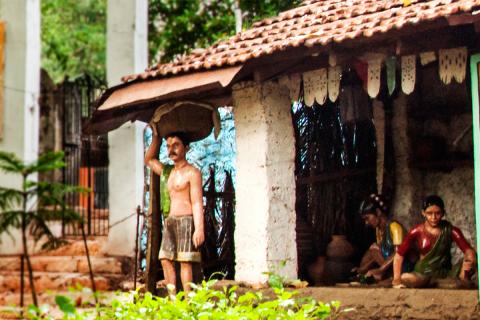
Dovornem - The load bearers weren't always animals in Goa - like oxen. People, laborers and the like, carried baskets laden with goods from one village to the next. This journey on foot often took a day or more.
Food was normally cooked in terra-cotta cooking pots (budkule and kudnim) each with its characteristic shape. [1]
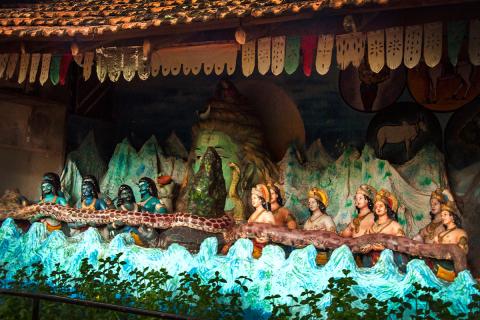
Samudra/Sagar manthan - In Hinduism, Samudra manthan or Churning of the Ocean of Milk is one of the best known episodes in Hinduism. The story appears in the Bhagavata Purana, the Mahabharata and the Vishnu Purana.[5]
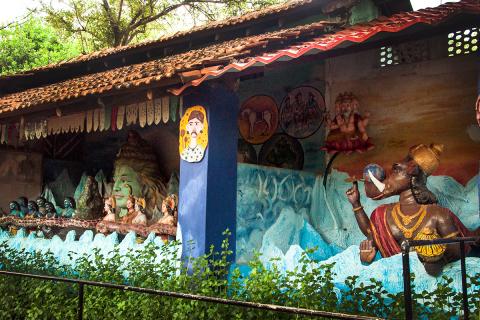
Anandachem Ghor[1] – Here you can see the sculptures of Samudra mantan and Dashavatara. Artists are made one of the avatara called Varaha.
Varaha is the avatar of the Hindu god Vishnu in the form of a boar. Varaha is listed as third in the Dashavatara, the ten principal avatars of Vishnu. When the demon Hiranyaksha stole the earth (personified as the goddess Bhudevi) and hid her in the primordial waters, Vishnu appeared as Varaha to rescue her. Varaha slew the demon and retrieved the Earth from the ocean, lifting it on his tusks, and restored Bhudevi to her place in the universe.[6]
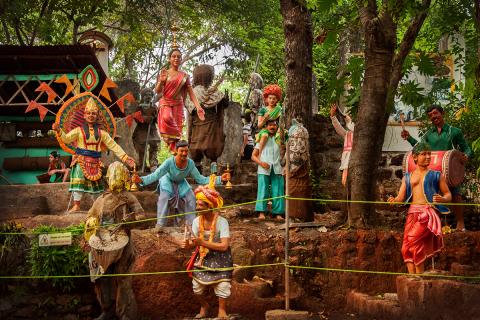
Fairs and Festivals of Goa - Religion is very close to the hearts of the Goans, rather their lives revolve around their gods and places of worship. No month passes without a fair or festival in Goa, every season is marked by fairs and festivals. Like rest of the India most Hindu, Christian and other religious festivals are celebrated here but then with Goan touch. Jatras (feasts) are a special feature of the Goan celebration where a palakhi or palanquin procession is carried out and thousands of people participate in it. Apart from these, there are other festivals which are exclusive to Goans. Some of these are the five day Shigmo festival, Kalas utsav, Novidade, Jatra of Shri Shanta Durga, Bonderam festival and the Goa Carnival.[7]
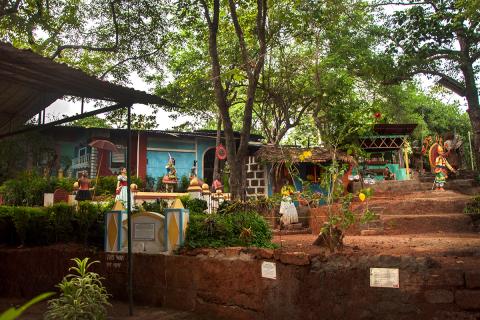
Bairo Alto - At “Ancestral Goa” this vital link betwixt the human race is highlighted at the Bairo Alto with figures depicting different religions. Their dress codes, styles of being and their predominant presence amongst environs that co-exist with each other and the eco system around is the highlight of this area.[1]
Fulkare ( Flower seller) - A very common sight outside temple, church and temple feasts, this flower vendor or fulkan wove intricate plaits of flowers with banana skin fibre and tough thread for the use around deities and also to decorate the well-oiled knots atop the heads of the ladies.[1]
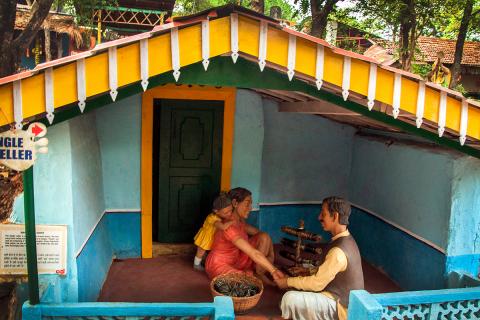
ZOVOINTO - The Bangle seller - He was a roaming trader who visited the houses when the ladies were free from their chores. Each color in the bangle depicts a certain reason for being worn. a multicolored set was worn by the bride-to-be to appease the ancestral souls. Red was worn by the bride after the wedding. Green was the color of fertility and black was worn by the widow.[1]
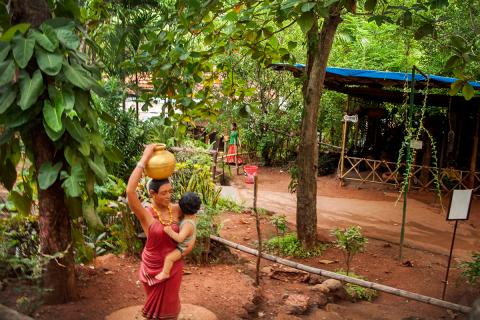
Village woman carrying water in pot on her head – There is something eternally graceful about seeing a women carrying a pot on her head. A vision of femininity, balance and sustenance with their gait being slow and gentle and their posture, dictated by maintenance of their load, remaining perfect. The daily pilgrimage to the village well was essential for supply of water for drinking, cooking and washing.[8]
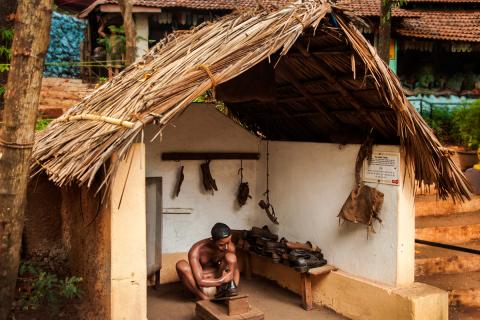
DAKU - The Chamar (cobbler) - Wooden clogs gradually made way for the lighter and longer lasting leather footwear. The cobbler sole craftsman of his trade with a sharp blade, needle, greases and slabs of leather fashioned footwear, made molds and designed simple but wearable patterns for feet that had a lot of walking to do. The chamar used to go house to house repairing and taking measurement for new footwear or could be found a little distance away from the tinto plying his trade.[1]
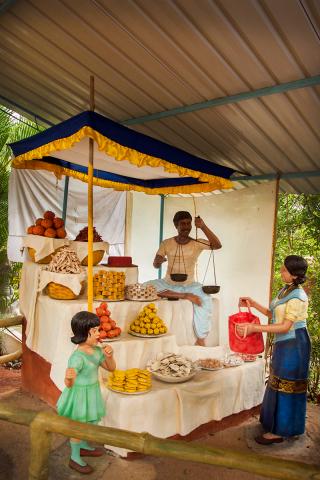
Tinto - The local market place as it were, can be likened to a crude, primitive departmental store where fish, meat and the local produce in vegetables and fruits, baskets, rope and even farming implements and livestock were sold.[1]

Gram Seller in local market place - The gram seller would roast the grams in a mud oven, in a traditional way. With the help of a long stick ‘doulo’ he would churn the grams in the sand and make them pop, serving them hot to his customers.[1]
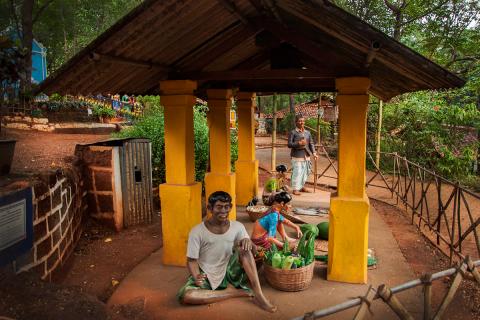
It is as essential an aspect of the village as its houses, church and temple. An open high dais with broad pillars and a tiled roof - the 'Tinto' was and till today, still is, a spacious & airy structure. Posters with important announcements were affixed on the pillars.[1]
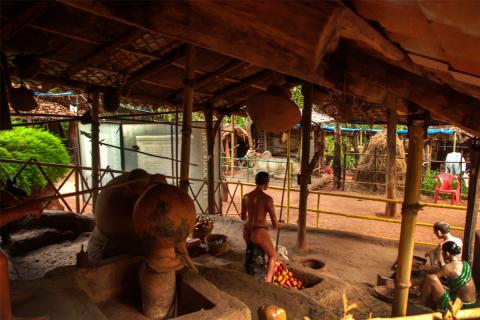
Brewing nectar / Ambrosia - One souvenir a visitor always carries home from his holidays in Goa are cashew nuts. Cashew trees abound the Goan hillsides. The flowering in January leads to luscious, brilliantly colored fruit in March, April and early May. It is then plucked, while the apple is used in the process of producing "Feni", the nuts are roasted for consumption.[1]
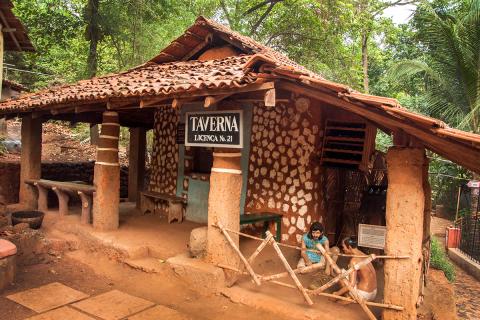
Taverna (The country liquor shop) - As a consequence of such an abundance in the production of such a variety and quantity of alcohol, as happens in Goa, small inns and bars, made an appearance. They first came onto the scene as 'Tavernas'.
These country liquor shops, built of mud & stone and partly white washed had a long verandah with wooden and mud benches and a roof made of Mangalore tiles. A wooden counter was fixed to the service window from where the drinks, pure cashew and coconut feni flavored with citrus peels or wild roots called "dudshiri".[1]
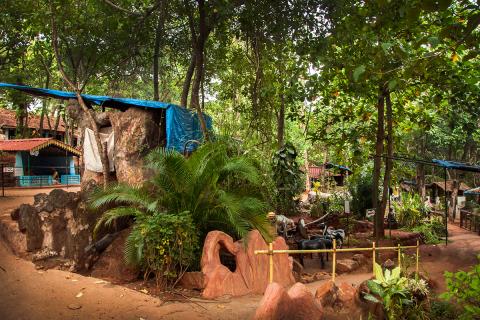
Here you can see the village life environment models and you can find Shepherd model.
Shepherd - Krish - The dhangers were nomads who traveled around with their herd of goats, and maintained a close relationship with the Goan Konkani peasants.[1]
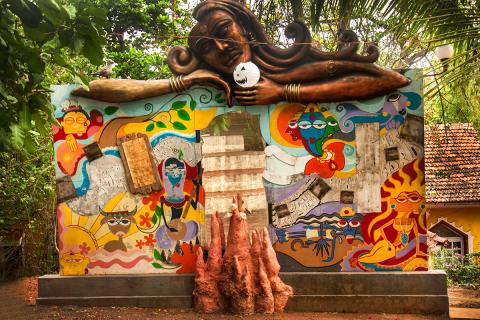
An installation by the Alvares family, entitled ‘She’ makes a fantastic backdrop for the stage area.[1]
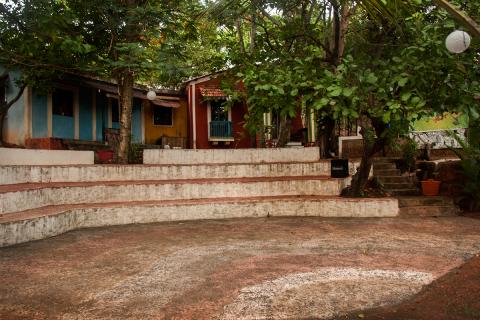
Bal Kala - The Bal Kala, is an open-air seating accommodation, modeled around an amphitheater. The Bal Kala has hosted programs such as open discussions part of the plastic drive, book releases, musical evenings, the coco’ju festival and educational programs aimed at children.[1]
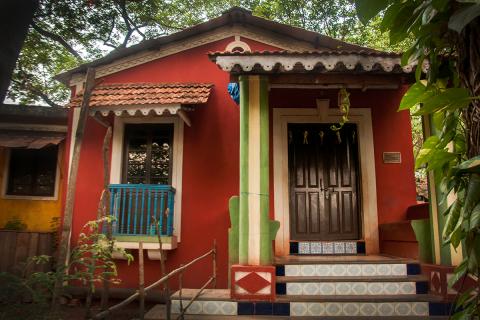
It’s a shop of seashell craft. Inside this shop you can find a lot of variety’s shell crafts.
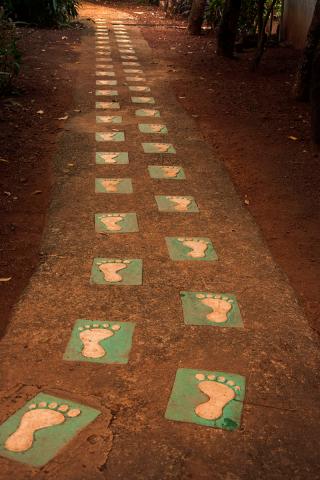
Pathway for the place called Legend of the Big Foot.
Legend of the Big Foot - Blessed with a deep sense of duty and unending goodness, a wealthy landowner by the name of Mahadar always helped the poor. Greedy neighbors wishing to take advantage of his good will kept on asking him for help till one day fleeced of all his possessions and destitute with the loss of his wife, he made do with what he got. The Gods seeing this good faith asked him for a boon, he asked for a small place to stand and pray. He was given a hot rock where he stood on one foot and prayed. Seeing his devotion the Gods took Him to heaven leaving his foot print behind with a boom “Anyone praying with a pure heart, will be blessed with luck”.[1]
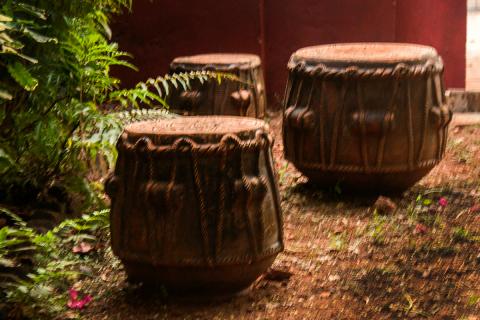
Goan cultural Thabala models. This instrument called Thabala used for Goan cultural programs or festivals.
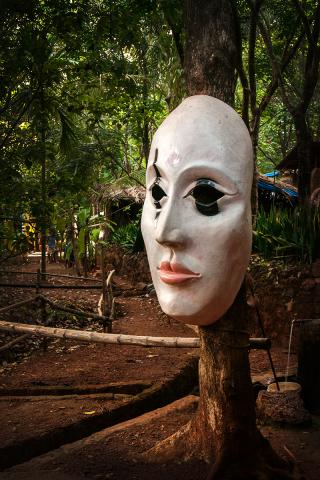
POP Female face mask is displayed on tree. This type of masks will used in Carnival.
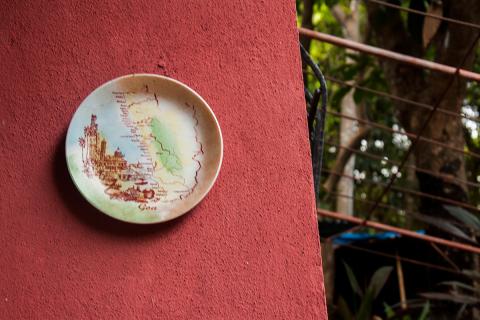
Artist is painted Bigfoot Museum place and Goa map on fiber plate is displayed on wall.
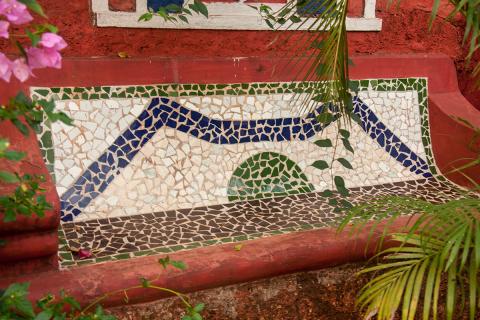
Using different color of tails Artist are made sun and mountain concept art on cement sitting bench.
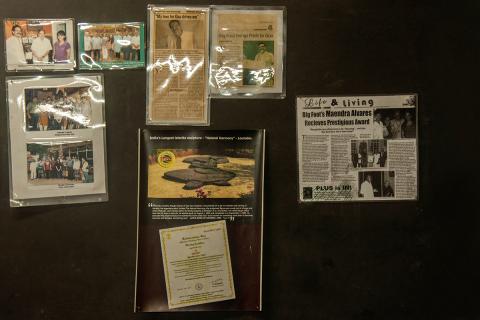
Some of article came in newspaper and some main event displayed on notice board.
In the year 1994 the sculpture of Sant Mirabai, India’s singing saint, which was begun and was finished in the period of one month. Carved on laterite it received National acclaim in the “Limca book of Records” in 1996 page 85. The sculpture was then christened “The Natural Harmony” in honor of the environs and the open and beautiful landscape.[1]
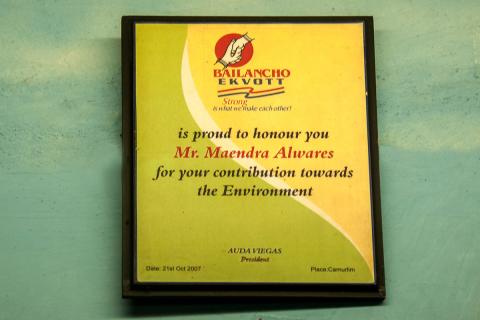
Auda Viegas president of Goan NGO Bailancho Ekvott is given certificate for best cultural environment shown in the museum.
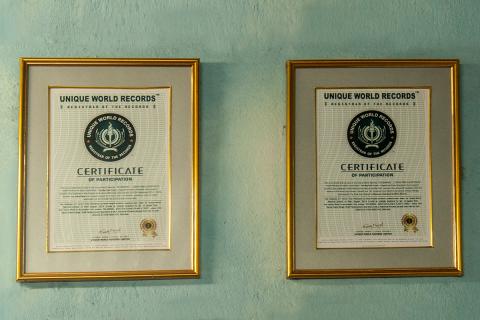
This museum got two Certificate of Participation from Unique World Records.
- http://www.ancestralgoa.com
- http://mewarudr.blogspot.in/2012/05/tradtional-games-in-rajasthan-india.html
- http://www.walkthroughindia.com/lifestyle/life-in-a-village-of-india/
- https://en.wikipedia.org/wiki/Dhani_and_villages
- https://en.wikipedia.org/wiki/Samudra_manthan
- https://en.wikipedia.org/wiki/Varaha
- http://www.indialine.com/travel/goa/culture.html
- http://www.veniceclayartists.com/women-with-pots/
This documentation was done by Prof. Bibhudutta Baral, Divyadarshan C S and Sandhya B. at NID, Bengaluru
You can get in touch with Prof. Bibhudutta Baral at
Email: bibhudutta[at]nid.edu
You could write to the following address regarding suggestions and clarifications:
Helpdesk Details:
Co-ordinator
Project e-kalpa
R & D Campus
National Institute of Design
#12 HMT Link Road, Off Tumkur Road
Bengaluru 560 022
India
Documentation By
Dr. Bibhudutta Baral
Divyadarshan C S
Sandhya B
Photography
Harsha Kumar N L
Sandhya B
Videography
Saurav N
Manmi D
Amulya S
Anila Srinivasa
Field Research Team
Harsha Kumar N L
Saurav N
Manmi D
Sandhya B
Amulya S
Anila Srinivasa -–B. Design student from Jawaharlal Nehru Architecture & Fine Arts University, Hyderabad
Project Head/Credits
Dr.Baral, Project Head
Email:bibhudutta@nid.edu
Mobile# +91 97397 18577
Key Contacts
Industrial Handicraft & Handloom Co-operative Society
Panaji
Goa
Cell phone:-07744831812



